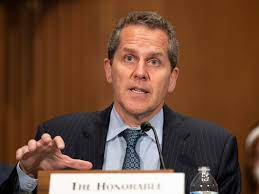
The Man Behind The Crypto Crackdown!! What’s Coming?!
What if I told you that the ongoing crypto crackdown is being coordinated by a member of the Federal Reserve?
Well, our research suggests that Michael Barr, the Fed’s vice chair for supervision, could be playing a key role.

His recent speech about keeping crypto out of the banking sector is the clearest evidence so far that he may well be pulling the strings.
Now to give you an idea of what Michael has in mind, he announced that the Fed will be establishing a team to address, quote, unregulated stable coins shortly before USDC lost its peg.
A coincidence, I’m sure. Today I’m going to give you a quick bit of background about Michael, summarise what he said in his recent speech and tell you what it could all mean for the crypto market.
If you’ve never heard of Michael Barr, here’s what you need to know.
Michael is a lawyer who has spent most of his career jumping between academia and the US government.
Michael is known for being one of the architects of the Dodd-Frank Act, the law passed after the 2008 financial crisis.
Before you roll your eyes, consider the following. The Dodd-Frank Act basically legalised bank bailins in the United States and paved the way for similar legislation around the world.
Thanks to Dodd-Frank, the money you have at the bank may be used to bail out that bank the next time there is a financial crisis.
The Dodd-Frank Act also created the Consumer Finance Protection Bureau or CFPB. The CFPB was proposed by Elizabeth Warren, the most anti-crypto-politician in the United States.
The CFPB was allegedly behind the original Operation Choke Point, which secretly cut off certain industries from the banking sector.
The fact that the CFPB was proposed by an anti-crypto-politician and was allegedly behind an operation to unbank certain industries in the past means it could be behind the current operation to unbank the crypto industry.
Now unfortunately, there’s no way of knowing for certain. The CFPB operates with next to no oversight. Despite being funded by the Fed and accounting for as much of 12% of the Fed’s total annual budget, the CFPB is not overseen by Fed officials nor by US politicians.
Michael may have some insight into this secretive agency given he co-authored the law that created it and seems to be friends with Elizabeth.
It seems that Michael also included something for himself in the Dodd-Frank Act too. That’s because Dodd-Frank also created a new position at the Fed.
Can you guess which position it is? That’s right, it’s the vice chair for supervision, the same position that Michael holds as of last summer.
Funny that. Now, if you watched our first video about Michael from last September, you’ll know that he also happens to be anti-crypto and even specified that one of his short-term goals was to go after the crypto industry.
Back then, I warned that Michael would use his powers to the fullest extent and… well, here we are.
On that note, you should know that amendments were made to the Dodd-Frank Act in 2018 which significantly reduced the powers that Michael would have in his current position.
As it so happens, the recent banking crisis could result in these amendments being rolled back, giving Michael yet more power.
If you watched our recent video about Jerome Powell’s testimony, you’ll know that Michael just so happened to be reviewing capital requirements at banks in the lead-up to the banking crisis.
It’s almost as if Michael knew that banking crisis was coming and was getting his recommendations ready in advance.
So, the speech I’ll be summarizing today was given by Michael the day before the banking crisis began to unfold.
It suggests that he and his anti-crypto allies plan on using the crisis to justify cutting the crypto industry and especially stable coins out of the banking system.
This is because crypto and especially stable coins are direct competitors to Fed Now.
For reference, Fed Now is a fast payment system that will be released by the Fed between May and July this year.
Fed Now is analogous to a central bank digital currency system. It’s essentially a step towards the creation of a digital dollar. Now, Michael mentioned in September that he was also focused on FedNow.
So, with that context in mind, let’s analyse exactly what Michael said about crypto in his recent speech.
As with Michael’s previous speech, this one took place at a think tank based in Washington, DC, called the Peterson Institute for International Economics.
Michael was introduced by a Georgetown University professor named Anna Gellpen, who later held a very interesting interview with him.
Michael started his speech by saying that the Fed wants to learn from the recent turmoil in the crypto markets.
He said that the Fed doesn’t want to stifle innovation but wants there to be strict crypto regulations, especially around stable coins.
This is exactly what Jerome said in his testimony the previous day.
Michael went on to highlight how he had spoken with college students who had lost money in crypto and acknowledged that around 20% of American adults have either held or still hold crypto.
He then presented an interesting dichotomy.
Regulation can support innovation or support existing institutions.
This dichotomy is interesting because it’s a tacit admission by Michael that crypto is a threat to existing institutions.
He said that too much regulation stifles innovation whereas too little regulation threatens existing institutions. Obviously, Michael and his colleagues are towards protecting the status quo.
Michael also admitted that regulation tends to have a hard time keeping up with innovation. He went on to claim that blockchain technology is beneficial, not cryptocurrency. He claimed that the benefits of crypto are, quote, inconsistent with reality and said that crypto adoption is, quote, contagious.
Michael also said that crypto adoption is ultimately due to the narrative of it being outside of government control and a hedge against inflation when it’s clearly correlated to other assets. He accurately pointed out that most of crypto claims to be decentralized, but most of crypto is actually centralized. You can find out what decentralization actually means using the link in the description.
I digress.
Michael continued by talking about how the collapse of FTX was one of many crypto catastrophes and claimed that crypto is attractive to criminals despite the fact that almost every transaction is publicly viewable and therefore traceable.
He concluded that crypto poses a threat to the banking sector. Naturally, Michael cited the collapse of Silver gate Bank as evidence of this threat and likely sees the recent collapse of Signature Bank as additional evidence.
He then revealed that the Fed is working with international authorities to ensure that there is no regulatory arbitrage, nowhere for crypto to run to.
Michael also revealed that any bank with current or prospective crypto clients must notify the Fed and that banks should not be holding any crypto on their balance sheets.
Something tells me that these banks will be subject to the additional capital requirements Michael has been planning for weeks.
Michael then stressed that banks need to be aware of the, quote, liquidity risks associated with stable coin deposits, a reference to the Fed’s most recent crypto warning in February.
Michael revealed that the Fed will continue to publish warnings about crypto with other regulators, namely the SEC and OCC.
Considering that every one of these crypto warnings has magically resulted in a crypto crackdown or catastrophe shortly afterwards, this revelation suggests that crypto isn’t out of the woods just yet.
Michael then explicitly stated that the Fed and its allies will continue to target stable coins in their warnings.
That’s because Michael believes that all stable coins must be subject to oversight by the Fed because stable coin adoption could be exponential and this risks massive runs on stable coin reserves.
Now this is yet another tacit admission from Michael that stable coins are direct competitors to Fed now and CBDCs.
After Michael finished his speech, Anna started her interview. The first question was eye-opening and it was whether the collapse of Silver gate was, quote, cryptos Dodd-Frank moment.
In other words, was the collapse of Silver gate the catalyst that will lead to the creation of another concerning set of laws?
What’s odd is that Michael didn’t say yes and part of me thinks that’s because he knew that Silver gate was only the first to fall.
In any case, he conceded that it was a wake-up call and a clear signal to the Fed that it needs to use its existing powers to cut crypto out of the banking sector, especially stable coins.
Noticing that he was eager to talk about stable coins, Anna asked Michael what the Fed had in mind regarding stable coin oversight, considering that stable coins are like money market funds.
Anna also added that the best way of getting rid of private money, like stable coins, is with public money.
CBDCs. Michael said that stable coins are, quote, unregulated and unsupervised, specifically that stable coins are, quote, unregulated money market funds operating on payment rails.
This is exactly what SEC Chairman Gary Gensler has been saying and Michael said that Jerome is on the same page as well.
Anna then asked Michael something along the lines of how long it will take for the Fed to crack down on stable coins.
Michael didn’t give a direct answer, but implied it would be soon. I suspect that the SEC will do most of the heavy lifting by trying to designate stable coins as securities.
Note that the SEC could be suing Paxos over its issuance of BUSD at any moment as we’re now past the 30-day Wells’ notice period.
Coinbase’s recent delisting of BUSD further adds to the FUD. Depending on the SEC’s reasoning with BUSD, we could see delistings of other stable coins by US exchanges.
Anyways, Anna went on to ask Michael whether the Fed’s crackdown on stable coins is in any way related to CBDCs.
Not surprisingly, Michael danced around the question.
However, he did admit that the Financial Stability Oversight Council or FSOC has been actively discussing stable coin regulation recently.
For those unfamiliar, FSOC is a US government agency consisting of members drawn from the Fed, the Treasury Department, the FDIC, and multiple other US regulators.
FSOC also has members from the CFPB, which is not surprising given that FSOC was also created by Dodd-Frank, presumably with Michael’s input.
Anyhow, Anna then asked Michael a good question, and that’s why the crypto crackdown is happening now and whether new crypto regulations will be required.
Michael said the crypto crackdown is happening now because small banks were effectively hiding their crypto exposure and have learned the hard way.
Regarding crypto-specific regulations, Michael said that existing regulations will be enough.
Now this is concerning because existing regulations were written long before financial technologies like cryptocurrencies existed.
They are very out of date, but Michael and his allies don’t seem to care. Once Anna was finished asking questions, she opened the floor up to the audience. One chap asked Michael about the EU’s crypto-specific regulations.
Michael said that the US is unlikely to create crypto-specific regulations and will likely adapt existing regulations so that they apply to the crypto industry.
Michael then dropped a bombshell, and that’s that the regulation by enforcement that we’ve seen from the Fed, the SEC, and other regulators will continue until Congress has addressed crypto regulations.
This is terrifying because Congress may not address crypto regulations until after the next election.
Michael then dropped another bombshell in response to a follow-up question by Anna, and that’s that the Fed has been working closely with the Financial Stability Board, or FSB, on global crypto regulations.
Note that the FSB is expected to release its global crypto-regulation recommendations. This upcoming June. If you watched our recent video about the FSB’s DeFi regulations, you’ll know that there’s a high likelihood that its regular crypto-regulation recommendations are probably going to be very bad.
Luckily, some jurisdictions, such as the UK and the EU, have started creating their own pro-crypto regulations.
Anyhow, another chap then asked Michael whether he sees stable coins and CBDCs as two separate things.
Michael said that right now the use case of stable coins is limited to crypto, and tacitly admitted that the Fed wants to keep it that way.
Michael also revealed something very significant about stable coins.
With CBDCs, the government will track every transaction and control saving and spending. With stable coins, however, if they were to become a payment method, the government would not be legally allowed to do any of these things.
Michael admitted that this was an advantage stable coins have over CBDCs.
Anna then asked Michael to talk about the losses related to investing in crypto.
Michael took a banking angle for his answer. He said that banks have limited exposure to crypto and the Fed wants to keep it that way. The takedown of signature by the Fed and its allies suggests they’re not playing around.
Now Anna’s last question was the same as her first. What about the Dodd-Frank moment in crypto? Michael said that it’s up to Congress to create a Dodd-Frank-type law for crypto.
He reiterated that in the absence of such a law, the Fed will continue using its existing authorities, i.e., continue cracking down on crypto.
This brings me to the big question, and that’s what Michael Barr’s comments mean for the crypto market.
Well, in short, they suggest that the crypto crackdown in the United States is just getting started, and it won’t end until Congress has come up with some reasonable crypto regulations to rein in the regulators.
As I mentioned earlier, this may not happen until after the next election.
This is because the original Operation Choke Point only ended in 2017, one year after a Republican government was elected in 2016.
Assuming we see the same timeline with Operation Choke Point 2, it could take until 2025 for that to end.
Now, that said, I reckon there’s only so much damage that Michael and his colleagues can do to the crypto industry between now and then.
Besides the fact that crypto companies and projects will be setting up shop overseas, crypto being cut out of the US banking sector could be the bottom, so to speak.
So far, we’ve seen all the crypto-friendly banks taken down, but many big banks are still servicing crypto companies and projects, including stable coin issuers.
Based on Michael’s comment, it’s possible that the bottom of this crypto crackdown will be marked by a the banking of one or more stable coin issuers.
This hasn’t happened yet, which logically suggests that the crypto crackdown isn’t over yet.
Given that the Fed and other regulators want to blame the banking crisis on the crypto industry, it’s possible that the banking stable coin issuers will be one of the solutions they propose.
There are many ways this the banking could manifest itself.
For example, if they really wanted to, they could go after the reserves that are backing stable coins.
May I remind you that it was recently reported that Tether was keeping almost half of its reserves in the United States?
The anti-crypto cabal could come up with a reason to seize or freeze Tether’s reserves pending some arbitrary investigation.
They could claim sanctions evasion, illicit activity, or merely take issue with the fact that Tether is based overseas and unregulated.
The Fed and its anti-crypto allies could also target circle by pointing to USDC’s recent depegging and the run on redemptions that it caused.
They could claim that had this run been larger, it could have further destabilized the banking sector.
Recall that the SEC is also on the cusp of officially suing Paxos over its issuance of BUSD.
Now, I have no idea what their reasoning will be, but they could repeat the debunked claim that finance was involved in illicit activity and that BUSD was somehow a part of it.
They could say the same about USDC and USDT.
Although this is all speculation, it’s evident that the Fed and its cabal are intent on cracking down on stable coins and this hasn’t really happened yet.
What this will look like is anyone’s guess, but I bet it will happen before the Fed releases Fed Now given that stable coins are seen as its direct competitor.
This means that it’s possible we could see a stable coin crackdown in the United States pretty soon.
You’ll know it’s here if the crypto market crashes and because I’ll be keeping you updated at every step of the ordeal.
Make no mistake though, whatever they throw at us, crypto will survive.
So, I’ll leave you with this thought.
There’s a saying in investing called don’t fight the Fed, which is a reference to the effects that the Fed’s rate hikes inevitably have on the market.
Not financial advice, but I would not suggest fighting the Fed when it comes to this crypto crackdown. You probably won’t win.
There’s a time and a place to fight the Fed on crypto, but the time and the place are both further along in the future.
From where I’m standing, it looks like the real crypto fight will begin in 2025 when central banks start holding cryptocurrency on their balance sheets.
There sure are some tough battles ahead folks, but I’m confident crypto will win out in the end. It costs some damage.


